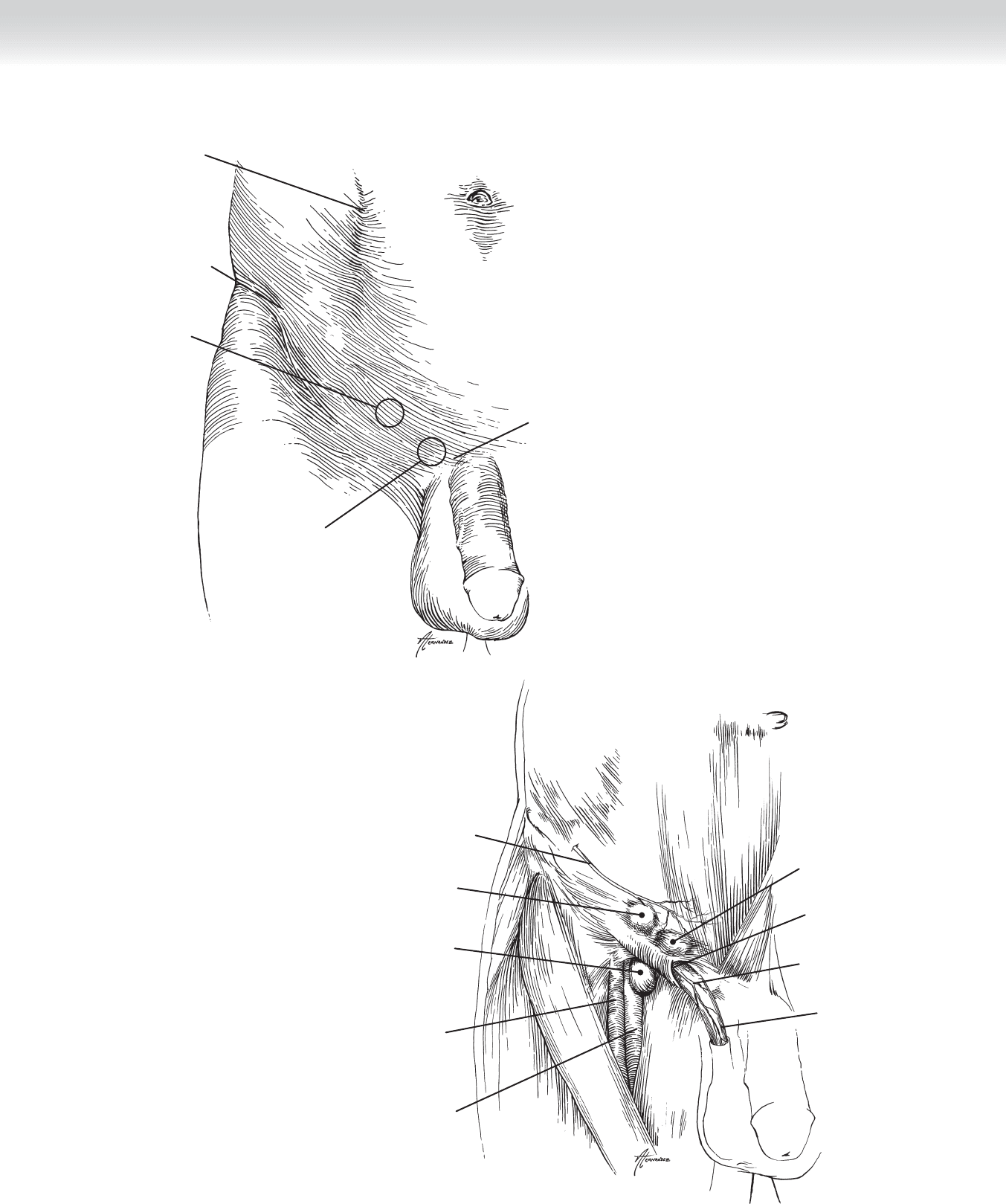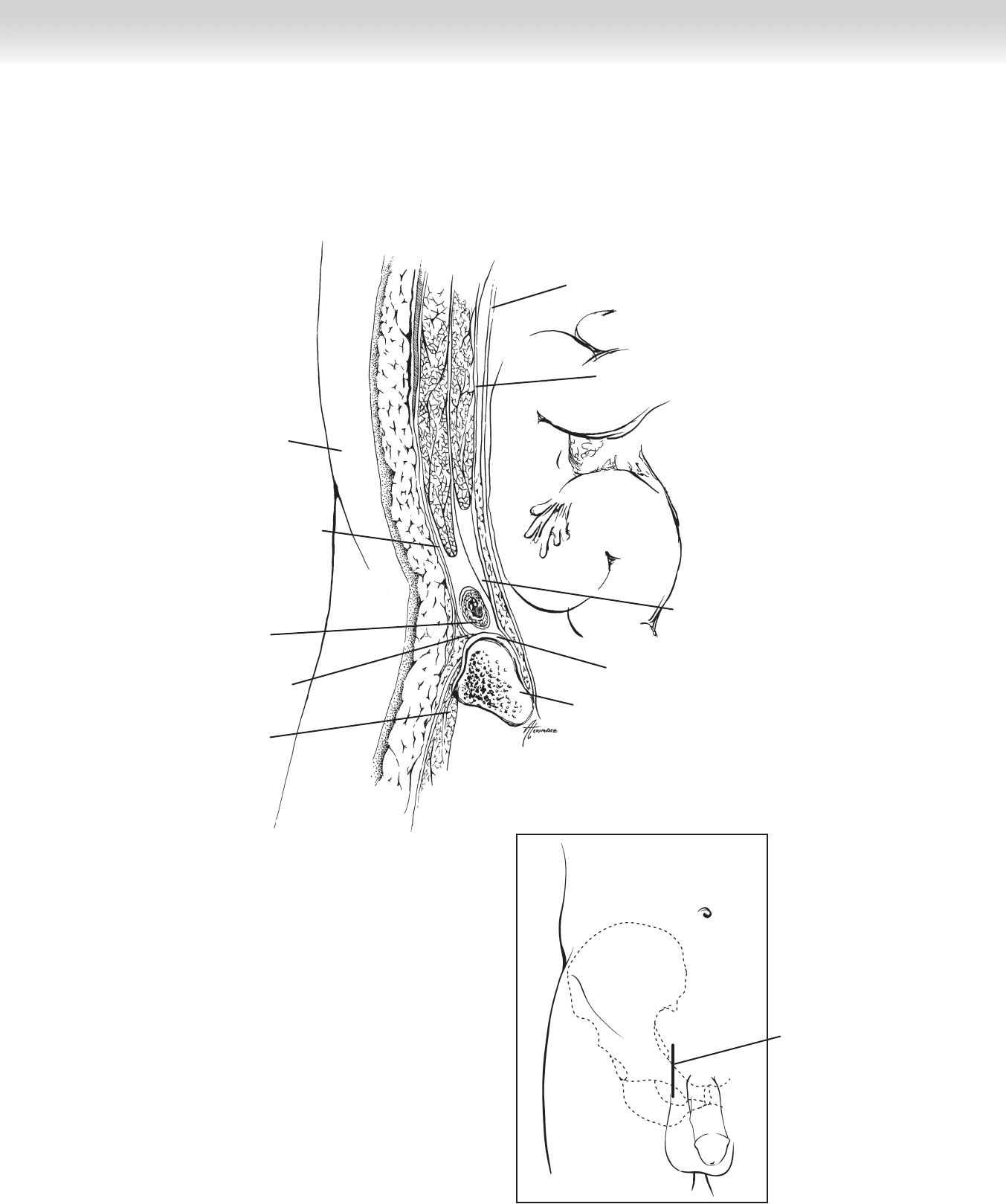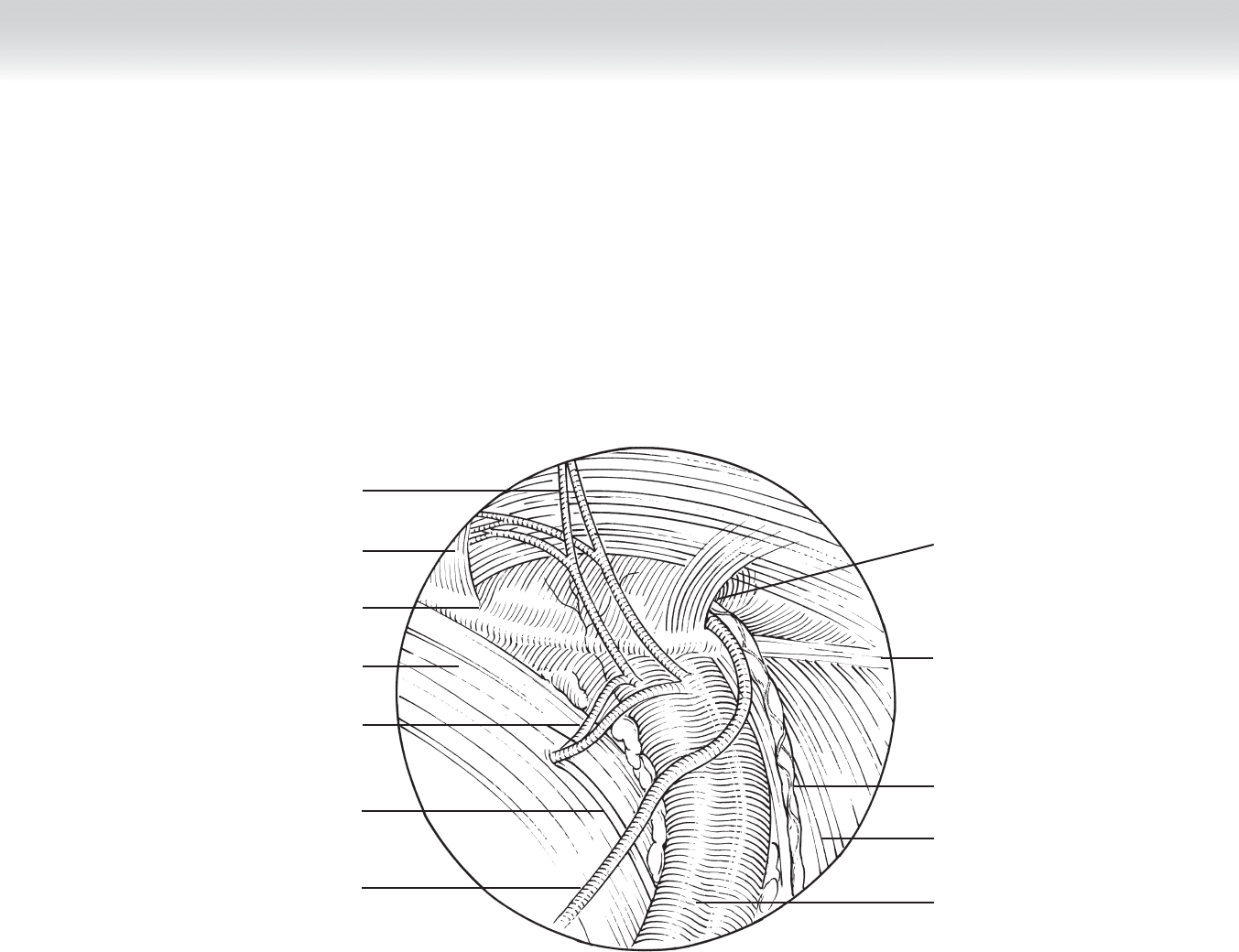Townsend Courtney M.Jr., Evers B. Mark. Atlas of General Surgical Techniques: Expert Consult
Подождите немного. Документ загружается.


778 Section X • Rectum
STEP 3: OPERATIVE STEPS
1. INCISION
◆ Adherent tape is placed along the medial aspect of the buttocks and retracted laterally.
2. DISSECTION
◆ Insert a probe through the external opening of the fi stula and gently advance the probe to
identify the fi stulous tract (Figure 70-2).
◆ With the probe in place, use a scalpel or electrocautery to incise skin overlying the fi stulous
tract (Figure 70-3).
◆ Most anal fi stulas arise from an anal crypt at the pectinate line; continue incision and expo-
sure of fi stulous tract to origin at anal crypt.
◆ Use electrocautery or curettage to cauterize and remove infl ammatory tissue along the fi stu-
lous tract (Figure 70-4).
◆ Many anal fi stulas extend internally to circumscribe the external and very rarely the internal
sphincters. To complete the fi stulotomy, the sphincter muscle can be cut, but the sphincter
muscle can be transected in only one place without precipitating incontinence.

CHAPTER 70 • Incision of Fistula-in-Ano 779
Probe
Mike de la Flor
FIGURE 70 –2
Electrocautery
FIGURE 70 –3
FIGURE 70 –4

780 Section X • Rectum
3. CLOSING
◆ For multiple, complex fi stula-in-ano, place a 2-0 silk suture through those fi stulous tracts
that circumscribe an anal sphincter yet cannot be incised. Tie the ends of this suture
together loosely to create a seton. With time the seton will incite suffi cient granulation and
fi brosis that the fi stulous tract can be incised at a second operation or allowed to erode
through the fi stulous tract.
STEP 4: POSTOPERATIVE CARE
◆ Sitz baths
◆ Stool softeners
◆ Repeat doses of mineral oil given orally
STEP 5: PEARLS AND PITFALLS
◆ It is sometimes diffi cult to assert with confi dence the path of the fi stula-in-ano. Goodsall’s
rule relates that if the external opening is anterior to an imaginary line drawn across the
midpoint of the anus and less than 3 cm from the anus, the fi stula usually runs directly into
the anal canal. If the external opening is anterior to but greater than 3 cm from the anus,
then the fi stulous tract may curve posteriorly to the posterior midline. If the external open-
ing is posterior to this line, the tract will usually curve to the posterior midline.
SELECTED REFERENCE
1. Zollinger RM Jr, Zollinger RM: Atlas of Surgical Operations, 5th ed. New York, Macmillan, 1983, p 420.

782
STEP 1: SURGICAL ANATOMY
◆ Although the widespread adoption of mesh to repair hernias may lead the inexperienced
and reckless to presume otherwise, a comprehensive understanding of the anatomy of the
inguinal region is of paramount importance in inguinal hernia repairs.
◆ See Figures 71-1 and 71-2 for surface and superfi cial anatomic structures. The typical loca-
tion of each of the three inguinal hernia types is shown in Figure 71-2.
CHAPTER
71
Hernia Repair: General
Principles—Tension-Free
versus Tension
Thomas D. Kimbrough

CHAPTER 71 • Hernia Repair: General Principles—Tension-Free versus Tension 783
Femoral artery
Femoral vein
Ilioinguinal nerve
Spermatic
cord
External
inguinal ring
Indirect hernia
Direct hernia
Femoral hernia
Iliohypogastric nerve
Semilunar line
Anterior superior
iliac spine
Site of deep
inguinal ring
Site of superficial
inguinal ring
Pubic tubercle
FIGURE 71 –1
FIGURE 71 –2

784 Section XI • Hernias
◆ Figure 71-3 is a parasagittal representation of the various layers at a point midway in the
right inguinal canal.
Cooper’s ligament
Skin
Pectineus muscle and fascia
External oblique aponeurosis
Spermatic cord and
cremaster muscle
Inguinal ligament
Superior ramus of pubis
Transversus abdominis
aponeurosis arch
Transversalis fascia
Peritoneum
A
Plane of section (A)
B
FIGURE 71 –3

CHAPTER 71 • Hernia Repair: General Principles—Tension-Free versus Tension 785
◆ Figure 71-4 is a view from the inner surface of the abdominal wall—that is, from the
preperitoneal space looking out.
FIGURE 71 –4
Epigastric vessels
Rectus muscles
Conjoined tendon
Cooper's ligament
Obturator vessels
Obturator nerve
Vas deferens
Anterior crus of
internal ring
Iliopubic tract
Internal spermatic
vessels
Psoas muscles
External iliac vessels
Normal Anatomic View

786 Section XI • Hernias
STEP 2: PREOPERATIVE CONSIDERATIONS
◆ The actual incidence of dangerous complications of untreated hernias is quite low, and the
mortal risk from these complications, when they do occur, is similarly low.
◆ The few deaths that result from hernia repair are far more likely to be due to complications of
comorbidities than operative complications, so any evaluation of a candidate for repair should
include careful attention to other medical problems. Appropriate evaluation and referral for
evaluation and treatment of other signifi cant medical problems should take precedence over a
recommendation for operative repair in elective cases.
◆ On the other hand, the probable natural course of an untreated inguinal hernia over time is
an increase in size and symptoms, so it is not unreasonable to offer repair to a young indi-
vidual with no other medical problems.
◆ The classic recommendation to evaluate and treat those conditions that might chronically
increase intra-abdominal pressure, including chronic cough, constipation, and diffi culty with
urination, fi ts under the previous admonition to evaluate comorbidities and does not other-
wise bear special consideration.
◆ In the fi nal analysis, the recommendation for a hernia repair requires of the surgeon a care-
ful balance and consideration of the natural history of untreated hernias, their symptoms
and complications, the patient’s age and comorbidities, and the presence of symptoms and
their immediate and anticipated effect on quality of life.
TENSION VERSUS TENSION-FREE
◆ A basic precept of surgery is that wounds closed under tension are less likely to heal well
than those closed with little or no tension.
◆ All of the classic tissue repairs require the approximation of tissues that do not exist in that
state naturally and thereby to one degree or another create tension on wound closures.
◆ Recognition of this has led to the use of mesh to bridge hernia defects and reinforce what has
been increasingly recognized as an often attenuated, hernia-prone portion of the abdominal
wall, even in those areas away from the actual hernia defect at the time of operation.
◆ The purported advantages of the tension-free repairs obtained with mesh include the
following:
◆ Mesh repairs have lower recurrence rates than tissue repairs.
◆ Postoperative pain is less, and recovery to full activity is faster.
◆ Long-term morbidity is the same as with tissue repairs.
◆ Although there are case reports of complications arising from the mesh itself, these are
suffi ciently rare to not preclude its use.

CHAPTER 71 • Hernia Repair: General Principles—Tension-Free versus Tension 787
◆ The ideal material for tension-free repair has not been identifi ed, and further research holds
the promise of developing materials, whether chemical or biologic, that will decrease even
further those problems associated with use of mesh.
◆ There are arguably some cases in which mesh should or cannot be used. For this reason,
surgeons should be familiar with classic tissue repairs, although one has to recognize that
the exposure of surgeons in training to these repairs will be quite limited in most cases.
STEP 3: OPERATIVE STEPS
1. INCISION
◆ The steps outlined here will be those used in the classic anterior approach to the inguinal
canal, which is satisfactory for the performance of most mesh and tissue repairs.
◆ Figure 71-5 illustrates two possible skin incisions for approaching the inguinal region. Inci-
sion A lies in the lower inguinal skin fold. Incision B directly exposes the external ring.
Anterior superior
iliac spine
Pubic tubercle
A
B
FIGURE 71 –5

788 Section XI • Hernias
◆ Before the incision is made, 0.25% bupivacaine with epinephrine should be injected medial
to the anterior superior iliac spine and deep to the external oblique aponeurosis. Approxi-
mate areas of injection are marked with an “X” on Figure 71-5. An additional 10 mL should
be injected at the site of the incision.
◆ The skin incision should be carried through the superfi cial subcutaneous fat, Scarpa’s fascia,
and the deep subcutaneous fat until the easily recognized oblique fi bers of the external
oblique aponeurosis are identifi ed.
2. DISSECTION
◆ The surgeon should then fi nd the external inguinal ring, obtaining exposure as illustrated in
Figure 71-6. Such exposure can be achieved with hand-held retractors or, as shown, with
self-retaining ones.
◆ As shown in Figure 71-6, the aponeurosis of the external oblique should be divided in the
line of its fi bers through the external inguinal ring. Some advocate the use of a knife for the
initial incision through the aponeurosis. I prefer scissors because they are less likely to
injure underlying structures.
◆ Using a combination of blunt and sharp dissection, the external oblique aponeurosis should
be freed superiorly and laterally from the underlying internal oblique muscle and fascia.
Inferiorly and laterally, the cord structures should be swept off the undersurface of the
external oblique aponeurosis down to the shelving edge of the inguinal ligament.
◆ The next step is longitudinal division of the fi bers of the cremaster muscle that invests the
structures of the spermatic cord as shown in Figure 71-7. Care should be taken to divide
the cremaster away from the ilioinguinal nerve.
